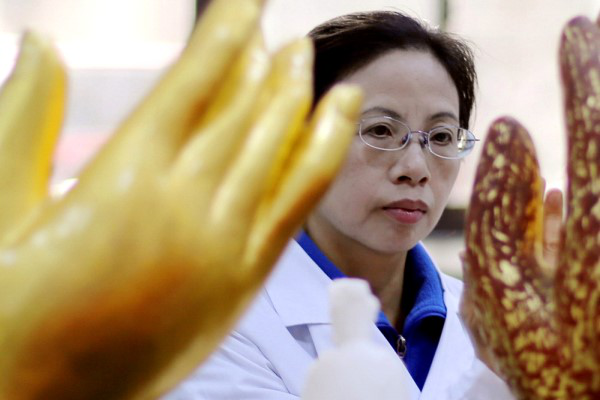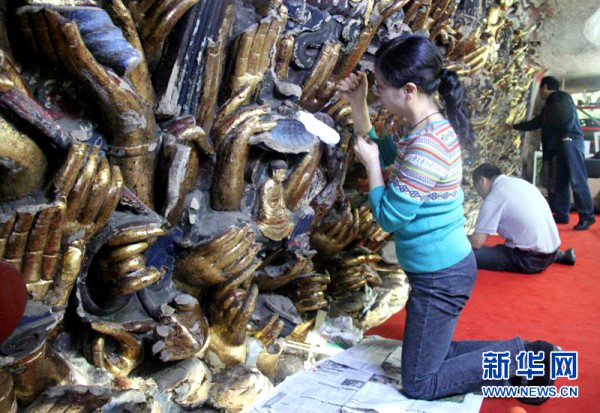
Woman Finds Self-Fulfillment in Restoring Cultural Relics
 |
| Chen Huili works at the Cultural Relic Protection Center of the Chongqing Dazu Grottoes Research Institute. [people.cn] |
Chen Huili, director of the Cultural Relic Protection Center of the Chongqing Dazu Grottoes Research Institute, has been taking care of cultural heritages for more than 20 years. She has led her team in preserving the national treasure Thousand-hand Kwan-yin, a statue of a Buddhist goddess, for eight years.
Chen was originally engaged in textile industry. To reunite with her husband, she became a cultural relic monitor in Southwest China's Chongqing Municipality. Since then, she has had an unbreakable bond with cultural relics.
In 1996, Chen got involved in the restoration of cultural heritages, which is the most technical work undertaken in the museum. It requires not only knowledge about history, archeology, epigraphy, chemistry and geology, but also techniques such as stone carving, painting and gilding. Chen was facing a huge challenge.
"Everything is done by someone," she said. "I believe I can do it!" To get acquainted with the work as soon as possible, Chen consulted colleagues during the day, and read books at night, spending almost all of her time at her new work.
Chen gradually found a sense of fulfillment. She feels that ancient relics have lives and stories, and that restorers can become "friends" with them.
Hard work pays off. Chen went from being a cultural relic monitor to a skilled cultural relic restoration worker.
In her work, Chen devised four diagnostic methods for ancient stone relics. The first is to look at the surface conditions, and to compare them with data and images; the second is to smell the odor on the surface to see if it has pollution or mildew; the next is to ask questions of the caregiver and learn about any changes to the relic; the last is feeling it with the hands, or using a silver needle to probe the weathering of the stone.
According to Chen's colleague Han Xiulan, this four-step diagnosis method can initially identify more than 20 problems with an accuracy rate of over 95 percent, which is basically the same as the results of professional instrument diagnosis.
In the eyes of Chen and her colleagues, stone carvings are precious, living treasures.
Chen often holds a scalpel to repair stone carvings in cramped spaces. She stares at the relics, polishing them with the scalpel and forceps little by little, and occasionally injects "medicaments" into the stone carvings. In this way, she sometimes has to stand for seven or eight hours a day.
The Dazu Grottoes are a model of the grotto art in ancient China, and also the most well-preserved grotto art in the world. However, after experiencing the high temperatures and humidity for more than 1,000 years, the carvings have entered a period of high-speed weathering. Its most famous work, the Thousand-hand Kwan-yin statue, is suffering from 34 different afflictions.
In 2008, the Thousand-hand Kwan-yin was listed as the No. 1 national stone cultural relics protection project by the National Cultural Heritage Administration, and Chen became the "stone doctor" who was entrusted to take the job.
"In addition to professional skills, we also need to have strong patience, perseverance and a sense of responsibility," Chen explained.
To reinforce the weathered stone, it is necessary to inject a kind of "medicament." However, the choice of "medicament" cost Chen a lot of time and effort, because the reinforcing agents used in northern areas are not suitable for high temperature and high humidity environments.
To find the best solution, Chen spent three years extracting different doses from more than 10 materials and repeated repair experiments on the cliff with her colleagues.
An agent with a 3 percent concentration finally ensured the safety and stability of the Thousand-hand Kwan-yin stone carving.
Aside from reinforcement, Chen also faced challenges in restoring the statue's appearance. For instance, to repair a 180-degree bent index finger, it was necessary to drill a small hole into the broken finger, and insert a 180-degree bamboo stick as a support, and then use mortar to shape the prototype finger and polish it smoothly. Each finger takes at least five days to be completed.
The statue has 830 hands, 440 of which are incomplete. Many of the fingers needed to be reinforced and repaired more than 10 times, and different hands have different problems.
To find the right remedy for each case, Chen and her colleagues filled out more than 1,030 questionnaires with about 35,000 pieces of data, 297 hand-drawn maps, 335 vector diagrams, and more than 1,300 photos. She independently completed the restoration plan and technical report of 80 hands and 20 artifacts.
Between 2008 and 2015, Chen stood on tall scaffolding every day, facing the rock wall, breathing in the pungent material, getting covered in dust and even maintaining one posture for a whole day.
Due to the limitations of the environment, air conditioning and stoves cannot be used in the restoration space. Chen had to overcome frostbite, mosquito bites, chemical agent allergies and other physical trials.
In 2015, the project was finally finished, and the Thousand-hand Kwan-yin conservation project was rated as a National Excellent Cultural Relics Protection and Utilization Project.
"When I see the golden light reappear, I think all our efforts are worthwhile," Chen said.
"Cultural relics work allows me to calm down, think and explore." In addition to the Dazu Grottoes, Chen also guided the restoration of painted stone in the Hebei Yuxian Museum, the Longmen Grottoes in Luoyang, Central China's Henan Province, Yulin Grottoes in Dunhuang, Northwest China's Gansu Province, and stone carvings in Danxia Mountain, South China's Guangdong Province.
She has also published more than 20 academic papers in core Chinese humanities journals and published a 450,000-word monograph which was regarded as a model of stone cultural relics protection.
In 2013, Chen was invited to Italy and stood on the podium of the National Academy of Sciences in Florence to introduce the rescue protection project of the Thousand-hand Kwan-yin. Her Italian counterparts were full of respect for this Chinese woman.
Due to her outstanding contribution to the cultural relics restoration, Chen won the honorary title of the National March 8th Red-banner Pacesetter this year. In 2016, the local government departments in Chongqing established an expert studio for her to pass on her spirit and skills.
In Chen's view, to pursue restoration skills, one must make their peace with loneliness first.
"A successful restoration technician can dialogue with the cultural relics in his or her heart. Whenever I see them, I seem to hear them talking," she said.
 |
| Chen Huili is absorbed in her work in a laboratory. [people.cn/Liu Yang] |
 |
| Chen Huili often keeps one posture in the restoration space during the work. [Xinhua] |
(Women of China)
Please understand that womenofchina.cn,a non-profit, information-communication website, cannot reach every writer before using articles and images. For copyright issues, please contact us by emailing: website@womenofchina.cn. The articles published and opinions expressed on this website represent the opinions of writers and are not necessarily shared by womenofchina.cn.
 京公网安备 11010102004314号
京公网安备 11010102004314号